Situated in the American Southwest, New Mexico boasts a rich biodiversity owing to its diverse landscapes that range from wide desert spaces to high mountain peaks.
This environmental diversity makes the state a fantastic habitat for a variety of wildlife, including a diverse array of owl species. If you are an ornithology enthusiast, a nature lover, or simply someone who enjoys spotting these intriguing creatures, then New Mexico is a must-visit state for you.
In this guide, we delve into the owl species that call New Mexico home and provide tips on how to spot them.
Owl Species Found in New Mexico
Northern Saw-Whet Owl

- Scientific name: Aegolius acadicus
- Size: 18-20 cm (7.1-7.9 in)
- Weight: 75-110 g (2.6-3.9 oz)
- Wingspan: 42-56.3 cm (16.5-22.2 in)
- Time of the year: Year-round
The Northern Saw-Whet Owl, with its distinctive white eyebrows and mesmerizing yellow eyes, is one of the smallest owl species found in New Mexico.
These owls inhabit wooded areas, especially those with mature coniferous trees, where they tend to nest in cavities left by woodpeckers. They are named for their unique call, which is said to resemble the sound of a saw being sharpened on a whetting stone.
In their diet, these owls mainly prey on small mammals like mice and voles, along with small birds and insects. They are known for their peculiar hunting style of catching prey and storing it for later when the food is abundant.
Did you know? The Northern Saw-Whet Owl gets its unique name from one of its many calls, which sounds like a saw being sharpened with a “whetting” or sharpening stone. However, this call is rarely heard, making it quite special when you do hear it in the wild.
Burrowing Owl
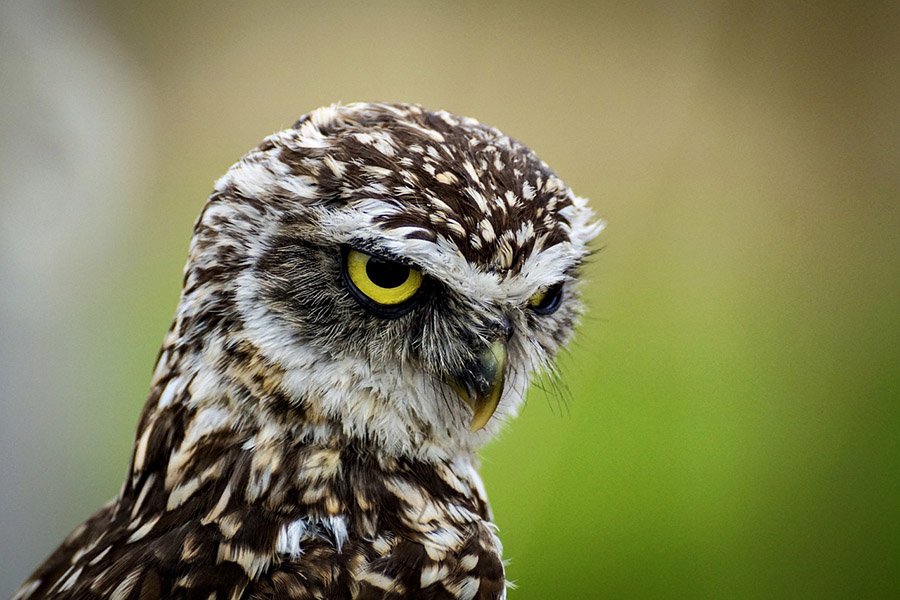
- Scientific name: Athene cunicularia
- Size: 19–28 cm (7.5–11.0 in)
- Weight: 140–240 g (4.9–8.5 oz)
- Wingspan: 50.8–61.0 cm (20.0–24.0 in)
- Time of the year: Year-round
The Burrowing Owl is easily distinguishable due to its long legs and ground-dwelling nature, a unique trait among owls. Native to the grasslands and desert regions of New Mexico, these owls often inhabit burrows dug by prairie dogs and other burrowing animals.
Their diet is diverse, consisting of small mammals, birds, reptiles, and insects. In contrast to many other owl species, the Burrowing Owl is diurnal, being most active during the day, although it hunts primarily at dusk and dawn. Their call is a distinctive two-part coo-coo, which they often repeat during the night.
Did you know? Unlike most owls, Burrowing Owls are often active during the day, although they tend to avoid the midday heat. But like many other birds, they are most active during the cooler hours of dawn and dusk.
Short-Eared Owl
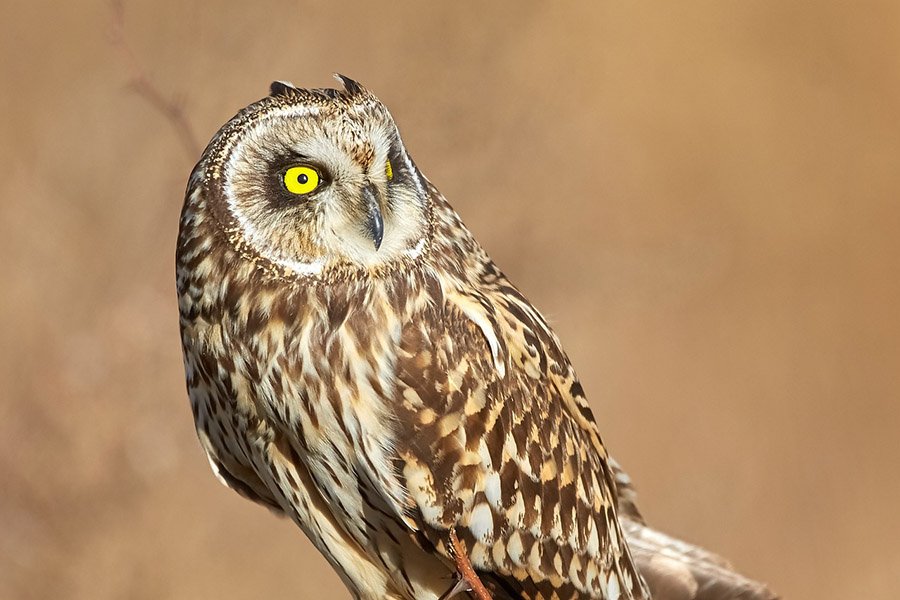
- Scientific name: Asio flammeus
- Size: 34–43 cm (13–17 in)
- Weight: 206–475 g (7.3–16.8 oz)
- Wingspan: 85–110 cm (33–43 in)
- Time of the year: Can be spotted primarily in the winter months
The Short-Eared Owl, named for its small ear tufts that are often difficult to see, is known for its wide distribution across the world. In New Mexico, these owls are primarily winter visitors, often seen hunting over open fields and grasslands at dusk and dawn. They fly close to the ground in a distinctive floppy flight pattern while looking for small mammals like mice and voles.
Short-Eared Owls are known for their dramatic courtship displays, which include sky-dancing, wing-clapping, and hoot sequences. They are also communal roosters, often found roosting in groups during the non-breeding season.
Did you know? The Short-Eared Owl is one of the most widely distributed owls, found on all continents except Antarctica and Australia.
Long-Eared Owl
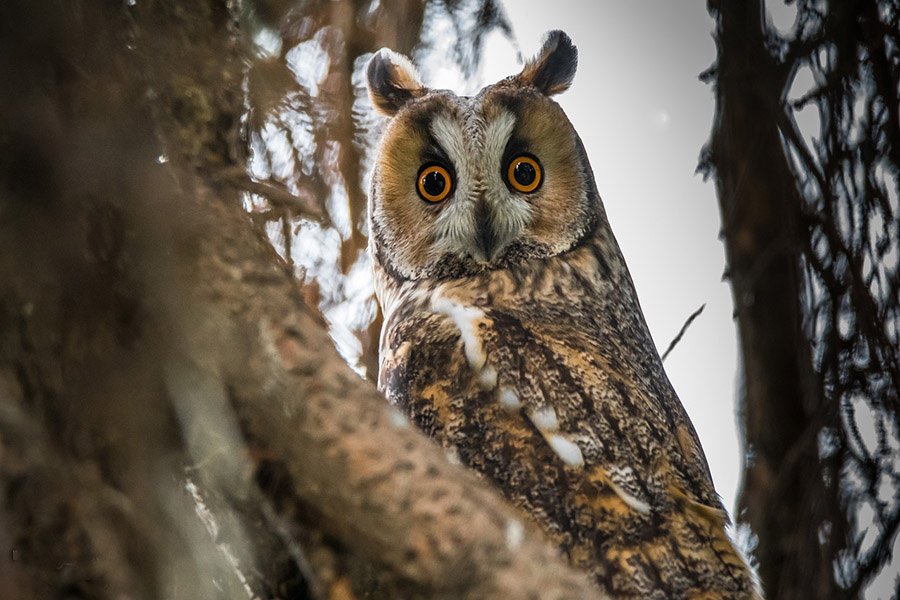
- Scientific name: Asio otus
- Size: 31–40 cm (12–16 in)
- Weight: 178–435 g (6.3–15.3 oz)
- Wingspan: 86–100 cm (34–39 in)
- Time of the year: Can be seen year-round, though easier to spot in the winter months
The Long-Eared Owl, as its name suggests, features prominent ear tufts, giving it a cat-like appearance. This owl species prefers dense forests near open country in New Mexico, taking advantage of both environments for roosting and hunting. Their diet primarily consists of small mammals, especially rodents, which they hunt during the night.
One distinctive behavior of the Long-Eared Owl is communal roosting during non-breeding seasons. It’s not uncommon to find several individuals roosting together in a single tree, often in the company of other owl species.
Did you know? In order to avoid detection by predators, the Long-Eared Owl will elongate its body and compress its feathers when alarmed, mimicking the look of a branch or tree trunk.
Barn Owl
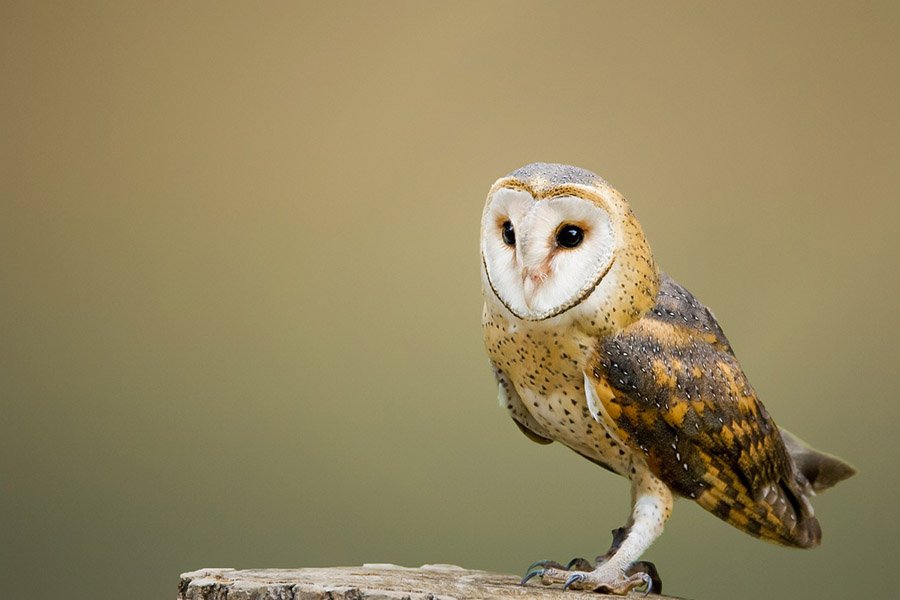
- Scientific name: Tyto alba
- Size: 33–39 cm (13–15 in)
- Weight: 224–710 g (7.9–25.0 oz)
- Wingspan: 80–95 cm (31–37 in)
- Time of the year: Can be seen year-round
Barn Owls are perhaps one of the most recognizable owl species, with their distinctive heart-shaped facial disk and pure white underparts. These owls are relatively common across New Mexico, often found nesting in barns, old buildings, or other man-made structures near open fields and meadows.
With an impressive hunting efficiency, Barn Owls feed mostly on small mammals like rats, mice, and voles, using their acute sense of hearing to locate prey in complete darkness. Their eerie, shrill screeches are a familiar sound in the rural areas of the state, contributing to various local folklore and myths.
Did you know? Unlike most owls, which hoot, Barn Owls communicate with an eerie, raspy screech. In fact, their calls are often described as some of the most frightening sounds in nature!
Boreal Owl
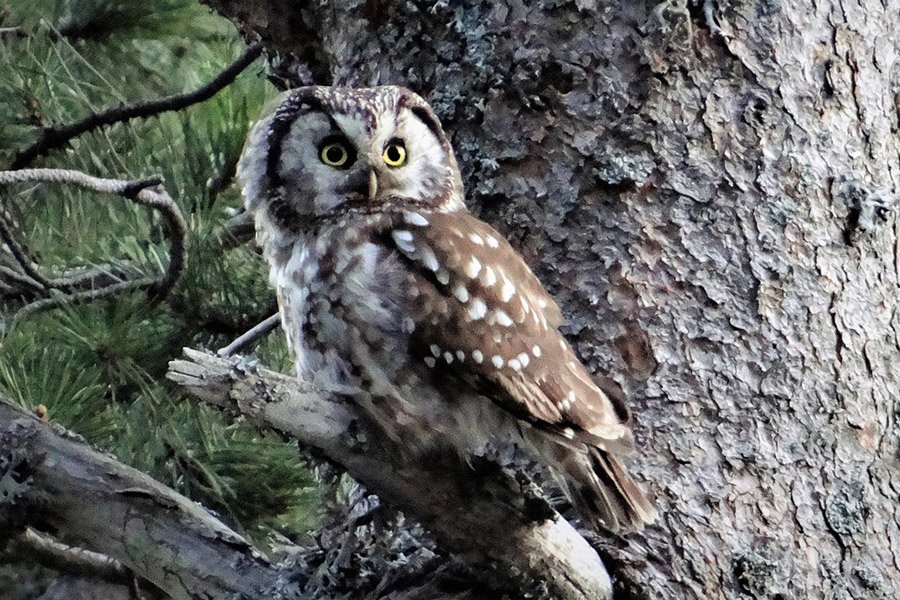
- Scientific name: Aegolius funereus
- Size: 22–27 cm (8.7–10.6 in)
- Weight: 93–170 g (3.3–6.0 oz)
- Wingspan: 53–61 cm (21–24 in)
- Time of the year: Year-round, although sightings are more common during the winter months
The Boreal Owl is a small, stout owl known for its large, yellow eyes and distinctive white spots on its head and wings.
These owls inhabit the dense coniferous forests found in the northern parts of New Mexico. Their diet consists mostly of small mammals, particularly voles, which they hunt during the night.
Due to their elusive nature and preference for deep forest habitats, Boreal Owls aren’t easily spotted. They’re most active at night, and their presence is often revealed by their unique, rhythmic, whistle-like calls that can carry over long distances in the silent winter nights.
Did you know? The Boreal Owl is also known as the ‘Tengmalm’s Owl’. This name comes from Swedish naturalist Peter Gustaf Tengmalm, who first described the species.
Western Screech Owl
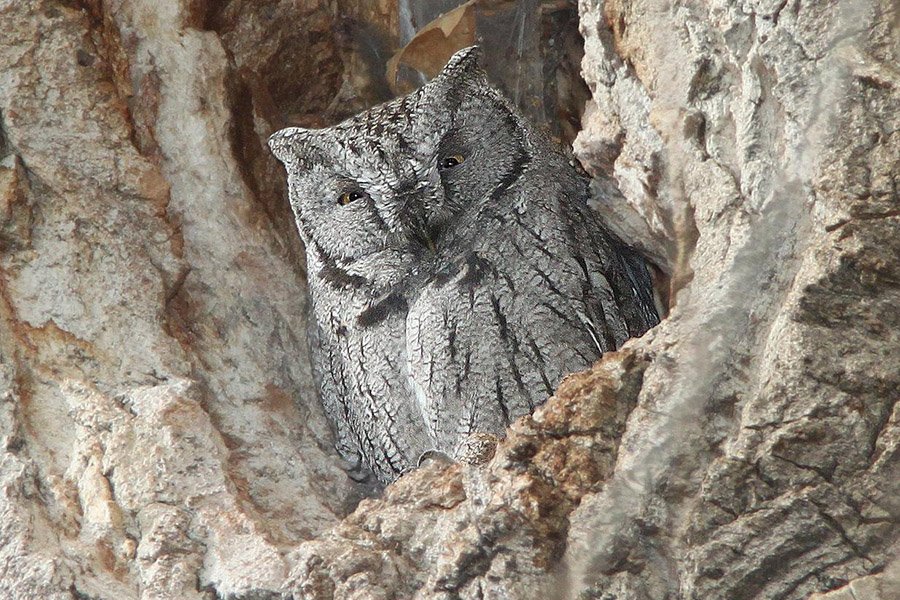
- Scientific name: Megascops kennicottii
- Size: 19–25 cm (7.5–9.8 in)
- Weight: 100–210 g (3.5–7.4 oz)
- Wingspan: 55–61 cm (22–24 in)
- Time of the year: Year-round
The Western Screech Owl is a small, compact owl found in various habitats across New Mexico, including woodlands, deserts, suburban areas, and even parks. It has a grey-brown plumage with intricate patterns that allow it to blend seamlessly into tree bark.
Despite the name, this owl does not screech. Instead, it has a series of whistles and hoots that are usually delivered in a distinctive, bouncing ball rhythm. These birds are opportunistic hunters, feeding on a wide range of prey, including insects, small mammals, and occasionally small birds.
Did you know? Western Screech Owls have been known to take over woodpecker holes, using them as nesting sites!
Great Horned Owl
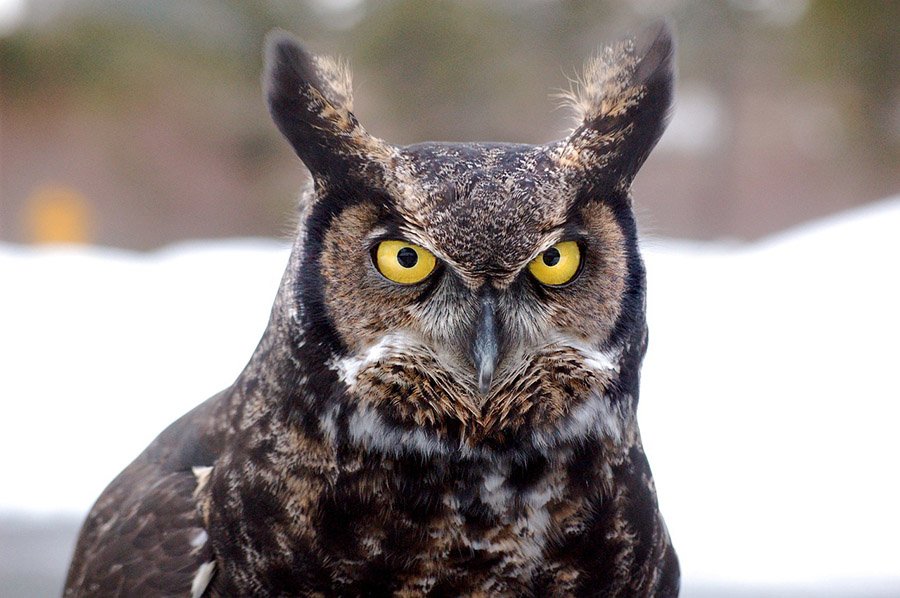
- Scientific name: Bubo virginianus
- Size: 46–63 cm (18–25 in)
- Weight: 910–2500 g (32–88 oz)
- Wingspan: 101–145 cm (40–57 in)
- Time of the year: Year-round
The Great Horned Owl, named for its ear-like tufts that appear to be “horns”, is one of the most common owls found throughout North America, and New Mexico is no exception. This owl is adaptable and can be found in various habitats, including mixed and coniferous forests, deserts, swamps, open grasslands, and even urban parks.
These birds are large and powerful predators. They primarily hunt at night, swooping down on unsuspecting prey from perches high in trees. Their diet is varied and includes rodents, rabbits, birds, reptiles, and even skunks.
Did you know? Great Horned Owls are one of the earliest breeding birds in North America. They are often heard calling to mates as early as January in deep midwinter.
Northern Pygmy-Owl
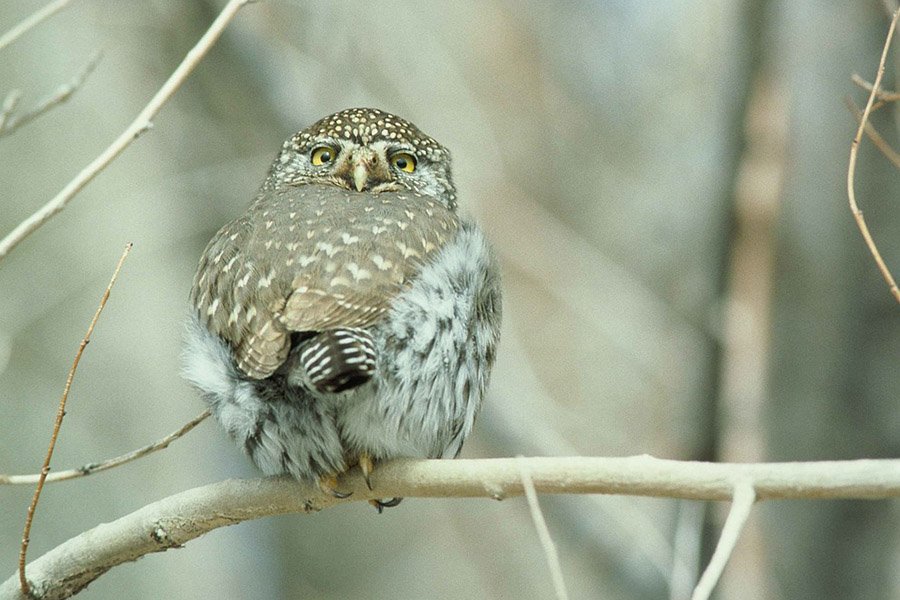
- Scientific name: Glaucidium gnoma
- Size: 16–18 cm (6.3–7.1 in)
- Weight: 62–73 g (2.2–2.6 oz)
- Wingspan: 38 cm (15 in)
- Time of the year: Year-round
The Northern Pygmy-Owl is a small owl species found in New Mexico. Despite its small size, this owl is a fierce hunter, often taking on prey bigger than itself, including large insects, birds, and small mammals. It hunts during the day, a trait that is rare among owl species.
They prefer dense forests and can often be spotted perched on a high vantage point looking out for their next meal. One of the distinctive characteristics of this species is its black nape with yellow eyespots, which can confuse predators into thinking it’s watching them.
Did you know? The Northern Pygmy-Owl is often mobbed by small birds. These smaller birds see the owl as a threat and gather around it, calling and fluttering, trying to get the owl to move on.
Spotted Owl
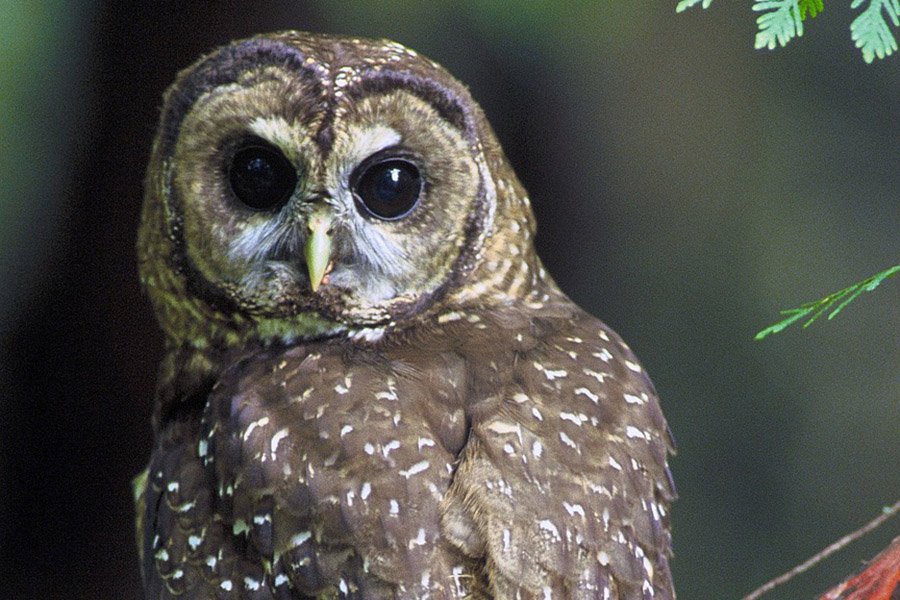
- Scientific name: Strix occidentalis
- Size: 43–48 cm (16.9–18.9 in)
- Weight: 600 g (21.2 oz)
- Wingspan: 114–124 cm (44.9–48.8 in)
- Time of the year: Year-round
The Spotted Owl, an iconic bird of the American Southwest, is a resident of New Mexico’s mature forests. It is medium-sized and has dark brown plumage interspersed with white spots, hence its name.
This owl has a preference for old-growth forests and typically nests in large tree cavities, broken-topped trees, and platforms in large trees.
These owls feed primarily on small mammals like mice, woodrats, and voles, which they capture during their nocturnal hunting forays. The presence of Spotted Owls is often a sign of a healthy forest ecosystem.
Did you know? The Spotted Owl is often at the center of conservation controversies due to its reliance on old-growth forest habitats, which are threatened by logging.
Elf Owl
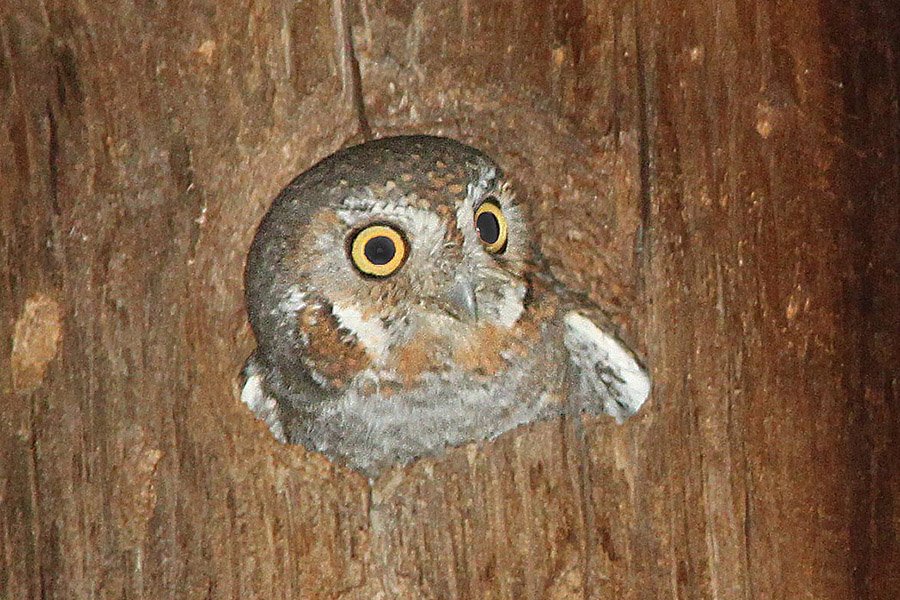
- Scientific name: Micrathene whitneyi
- Size: 12.5 cm (4.9 in)
- Weight: 40 g (1.4 oz)
- Wingspan: 27 cm (10.6 in)
- Time of the year: Spring and Summer
The Elf Owl, the world’s lightest owl, also calls New Mexico home. It can be found in the desert and dry shrubland regions of the state, especially those with saguaro cacti and mesquite.
As the smallest owl species in the world, the Elf Owl is not much bigger than a sparrow, but it is a tenacious predator of insects, spiders, and sometimes even small lizards and birds.
The Elf Owl migrates to New Mexico for breeding season, typically between March and September. It’s known for nesting in abandoned woodpecker holes in cacti or trees.
Did you know? Despite their small size, Elf Owls are quite the vocalists, with a complex repertoire of toots, chattering sounds, and chuckles that can be heard during the breeding season.
Whiskered Screech Owl
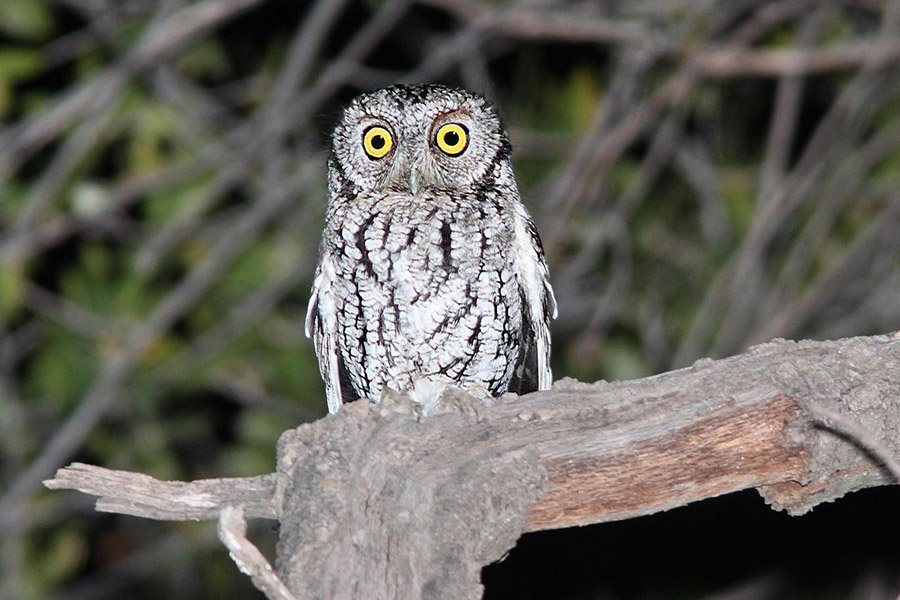
- Scientific name: Megascops trichopsis
- Size: 22–24 cm (8.7–9.4 in)
- Weight: 125 g (4.4 oz)
- Wingspan: 53–58 cm (20.9–22.8 in)
- Time of the year: Year-round
The Whiskered Screech Owl is one of New Mexico’s lesser-known residents. Small yet stocky, this owl has a greyish-brown color that helps it blend into the tree bark in its preferred habitat of mature forests, especially in riparian areas. The characteristic ‘whiskers’ are actually feathers which form a distinct facial disk.
Unlike other owl species, the Whiskered Screech Owl has an incredible array of vocalizations, including barks, hoots, and a melodic trill that can be heard during the night. It feeds primarily on insects and other small invertebrates.
Did you know? The Whiskered Screech Owl’s songs vary greatly from place to place, to the point where neighboring owls may have completely different songs!
Flammulated Owl
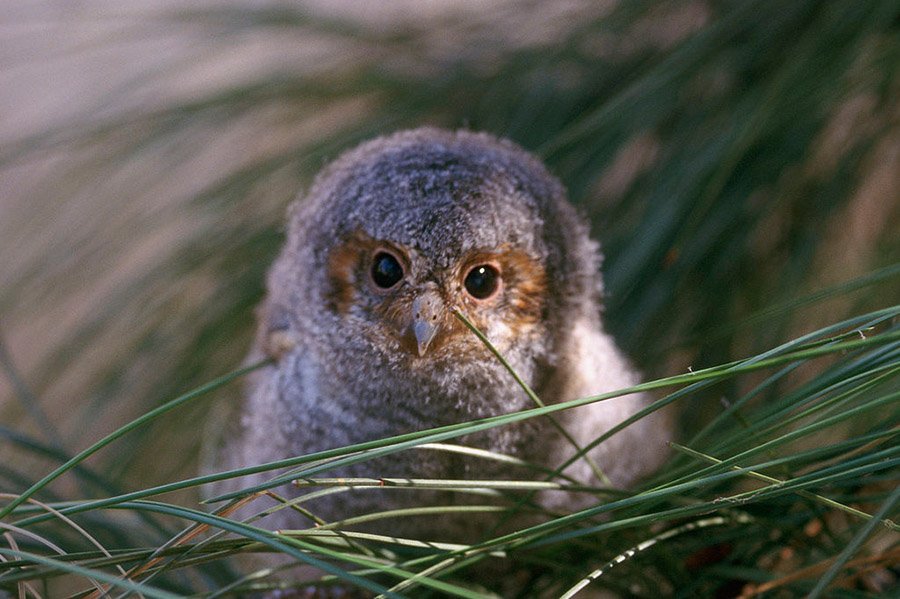
- Scientific name: Psiloscops flammeolus
- Size: 15–17 cm (5.9–6.7 in)
- Weight: 50–62 g (1.8–2.2 oz)
- Wingspan: 36–42 cm (14.2–16.5 in)
- Time of the year: Spring and Summer
The Flammulated Owl is another petite bird of prey that can be found in New Mexico. These small, elusive owls prefer high-altitude, old-growth forests, particularly those with a mixture of coniferous and deciduous trees. The owl’s name comes from its flame-like plumage, which provides perfect camouflage against tree bark.
Flammulated Owls are migratory and usually arrive in New Mexico in spring for the breeding season. They primarily feed on insects, particularly moths and beetles, which they hunt at night.
Did you know? Unlike many owl species, the Flammulated Owl has dark eyes instead of the usual yellow, which gives it a distinct appearance and aids in camouflage.
Where & How to Observe Owls in New Mexico
New Mexico’s diverse habitats, from the desert plains to the high-altitude forests, make it a haven for various owl species. If you’re an avid bird watcher or a curious adventurer, there are many places where you can spot these magnificent creatures.
- Gila National Forest: Located in southwestern New Mexico, the Gila National Forest is an excellent place to spot a variety of owls, including the Northern Pygmy-Owl, the Northern Saw-Whet Owl, and the Great Horned Owl.
- Bosque del Apache National Wildlife Refuge: This refuge is a fantastic spot to find Burrowing Owls, as the open grasslands provide ideal habitats for these ground-dwelling owls.
- Sangre de Cristo Mountains: The higher altitudes of these mountains are home to Boreal Owls, which are often heard more than seen due to their nocturnal nature.
- Bandelier National Monument: This national monument offers a good chance of spotting various owls, including the elusive Flammulated Owl.
In terms of habitats, owls can be found across New Mexico in various environments, from the desert plains to riparian forests. Barn Owls prefer open areas such as grasslands and deserts, while Great Horned Owls and Northern Saw-Whet Owls favor wooded areas.
Specific tips to spot owls include venturing out at dusk or dawn when many species are most active. Listening to their distinct calls can also help locate these birds, especially in dense forest habitats.
Quick Tips For Owl Spotting
- Stay quiet and patient. Owls can be easily scared off by loud noises.
- Bring binoculars for the best viewing experience.
- Remember not to disturb or approach nests too closely.
- Go with a guide if you’re unfamiliar with the area or owl behaviors.
- Lastly, respect the owls and their habitat. We’re the visitors in their home.
Owls in Other States
- Alabama
- Alaska
- Arizona
- Arkansas
- California
- Colorado
- Connecticut
- Delaware
- Florida
- Georgia
- Hawaii
- Idaho
- Illinois
- Indiana
- Iowa
- Kansas
- Kentucky
- Louisiana
- Maine
- Maryland
- Massachusetts
- Michigan
- Minnesota
- Mississippi
- Missouri
- Montana
- Nebraska
- Nevada
- New Hampshire
- New Jersey
- New Mexico
- New York
- North Carolina
- North Dakota
- Ohio
- Oklahoma
- Oregon
- Pennsylvania
- Rhode Island
- South Carolina
- South Dakota
- Tennessee
- Texas
- Utah
- Vermont
- Virginia
- Washington
- West Virginia
- Wisconsin
- Wyoming





